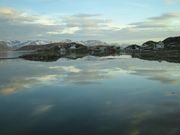 Satellite images used to assess coastal and sea water quality
Satellite images used to assess coastal and sea water quality
A recent study has found that satellite images can be used to map phytoplankton blooms to aid assessment of the quality of coastal and sea waters. This method can help EU Member States monitor water under the requirements of the Water Framework Directive and the Marine Strategy Framework Directive.
In Europe, fresh and coastal waters are protected by the Water Framework Directive (WFD)1 and the seas are protected by the Marine Strategy Framework Directive (MSFD)2. Member States are required to achieve or maintain ‘good ecological status’ for all fresh and coastal waters by 2015 under the WFD and to achieve or maintain ‘good environmental status’ within in their marine waters by 2020 under the MSFD.
To reach these targets, water quality must be assessed and monitored. Traditionally, water quality has been measured by analysing water samples taken from monitoring stations along the coast. However, more extensive and frequent assessment of water quality is needed under both Directives. Using satellite imagery to complement these ‘in-situ’ measurements can provide a more detailed picture over a wider area.
Partly conducted under the EU WISER3 and LOREA4 projects, this study compared the ecological status of water in the south-eastern Bay of Biscay, north of Spain, provided by satellite images, with in-situ chlorophyll-a measurements. Chlorophyll-a is a coloured pigment found in phytoplankton that can be picked up by satellite images; one of the criteria used for assessing water quality is the concentration of phytoplankton distributed in the water. Phytoplankton blooms can occur when excessive quantities of nutrients, especially nitrogen and phosphorus, are discharged into the water from human activities, mainly farming, and can lead to eutrophication, when water quality is damaged through reduced oxygen levels and increased levels of organic matter and cloudiness in the water.
A total of 962 satellite images of the study region were downloaded from MODIS5, a NASA service, for the period 2005 to 2010. Only images that were free of clouds were downloaded. In-situ sampling suggests the water quality at all monitoring stations in the study region was of ‘high’ quality. In comparison, the satellite map suggested just 70% of water at the monitoring stations had a ‘high’ status, with water at the other stations having a ‘good’ water quality status. This difference could be due to the satellite imagery slightly overestimating the concentration of chlorophyll-a or an underestimation of chlorophyll-a from in-situ measurements. Nevertheless, the various water bodies as a whole (represented by more than one monitoring station) showed an overall ‘high’ quality status, broadly agreeing with the quality assessment resulting from in-situ measurements. Both assessments agreed that there is a low risk of eutrophication in the south-eastern Bay of Biscay coastal and offshore waters.
Satellite imagery can capture autumn-winter and winter-spring phytoplankton blooms that in-situ measurements can miss. Furthermore, in-situ monitoring is not carried out frequently enough, owing to high costs and time constraints, and the phytoplankton blooms might not occur at the same time as the one-day monitoring efforts.
- See: http://ec.europa.eu/environment/water/water-framework/index_en.html
- See: http://ec.europa.eu/environment/marine/eu-coast-and-marine-policy/marine-strategy-framework-directive/index_en.htm
- WISER (Water bodies in Europe: Integrative Systems to assess Ecological status and Recovery) is supported by the European Comission under the Seventh Framework Programme. See: www.wiser.eu
- LOREA (Litoral, Ocean and Rivers in Euskadi-Aquitaine) is funded by the European Structural funds Programme INTERREG Iva. See: www.lorea.eu
- See: http://modis.gsfc.nasa.gov
| Contact information |
Novoa, S.
(email: snovoa@gmail.com) |
|---|---|
| News type | Inbrief |
| File link |
http://modis.gsfc.nasa.gov |
| Source of information | Novoa, S., Chust, G., Sagarminaga, Y. et al. (2012) Water quality assessment using satellite-derived chlorophyll-a within the European directives, in the southeastern Bay of Biscay. Marine Pollution Bulletin. 64: 739–750. DOI: 10.1016/j.marpolbul.2012.01.020. via (Science for Environment Policy, Issue 289: A service from the European Commission) // EC DG Environment |
| Keyword(s) | EU-WFD, Marine ecosystems, MODIS |
| Subject(s) | INFORMATION - COMPUTER SCIENCES , MEASUREMENTS AND INSTRUMENTATION , METHTODOLOGY - STATISTICS - DECISION AID , NATURAL MEDIUM , PREVENTION AND NUISANCES POLLUTION , RISKS AND CLIMATOLOGY , TOOL TERMS |
| Relation | http://www.emwis.net/initiatives/dce |
| Geographical coverage | n/a |
| News date | 21/06/2012 |
| Working language(s) | ENGLISH |
 you are not logged in
you are not logged in





